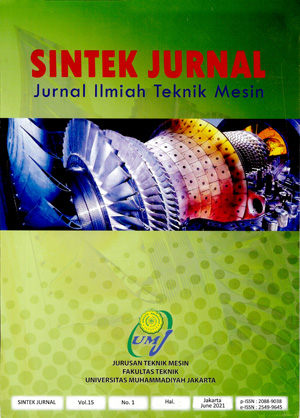PUMP AS TURBINES (PATS) DESIGN OPTIMIZATION AS A RENEWABLE ENERGY SOURCE ALTERNATIVE
Main Article Content
Abstract
Article Details
- Articles published in SINTEK JURNAL are licensed under a Creative Commons Attribution-ShareAlike 4.0 International license. You are free to copy, transform, or redistribute articles for any lawful purpose in any medium, provided you give appropriate credit to the original author(s) and SINTEK JURNAL, link to the license, indicate if changes were made, and redistribute any derivative work under the same license.
- Copyright on articles is retained by the respective author(s), without restrictions. A non-exclusive license is granted to SINTEK JURNAL to publish the article and identify itself as its original publisher, along with the commercial right to include the article in a hardcopy issue for sale to libraries and individuals.
- By publishing in SINTEK JURNAL, authors grant any third party the right to use their article to the extent provided by the Creative Commons Attribution-ShareAlike 4.0 International license.
References
Derakhshan S, and Nourbakhsh A., ―Theoretical, numerical and experimental investigation of centrifugal pumps in reverse operation‖. Experimental Thermal and Fluid Science; Volume 32, Issue 8, pp. 1620-7, 2008
Himawanto DA, Tjahjana DD, Hantarum. Experimental study on optimization of curvature blade impeller pump as turbine which functioned as power plant picohydro. InAIP Conference Proceedings 2017 Jan 3 (Vol. 1788, No. 1, p. 030008). AIP Publishing LLC.
Fuhaid N. Pengaruh Sudut Pipa Pesat Terhadap Efisiensi Pembangkit Listrik Tenaga Mikrohidro (Pltmh). PROTON. 2012 Mar 1;4(1).
Cahyono SI, Pitana TS. Eksperimental Optimasi Tipe Lekuk Sudu Pada Pompa Difungsikan Sebagai Turbin Untuk Pembangkit Listrik Tenaga Picohidro. Mekanika. 2016 Mar 14;15(1).
Rafl D, Hazwi M. Simulasi Numerik Penggunaan Pompa Sebagai Turbin Pada Pembangkit Listrik Tenaga Mikro Hidro (Pltmh) Dengan Head 9, 29 M Dan 5, 18 M Menggunakan Perangkat Lunak Cfd Pada Pipa Berdiameter 10, 16 Cm. e-Dinamis. 2014 Mar 1;8(4).
Agarwal T. Review of pump as turbine (PAT) for micro-hydropower. International Journal of Emerging Technology and Advanced Engineering. 2012 Nov;2(11):163-9.
Williams AA. Pumps as turbines for low cost micro hydro power. Renewable Energy. 1996 Sep 1;9(1-4):1227-34.


